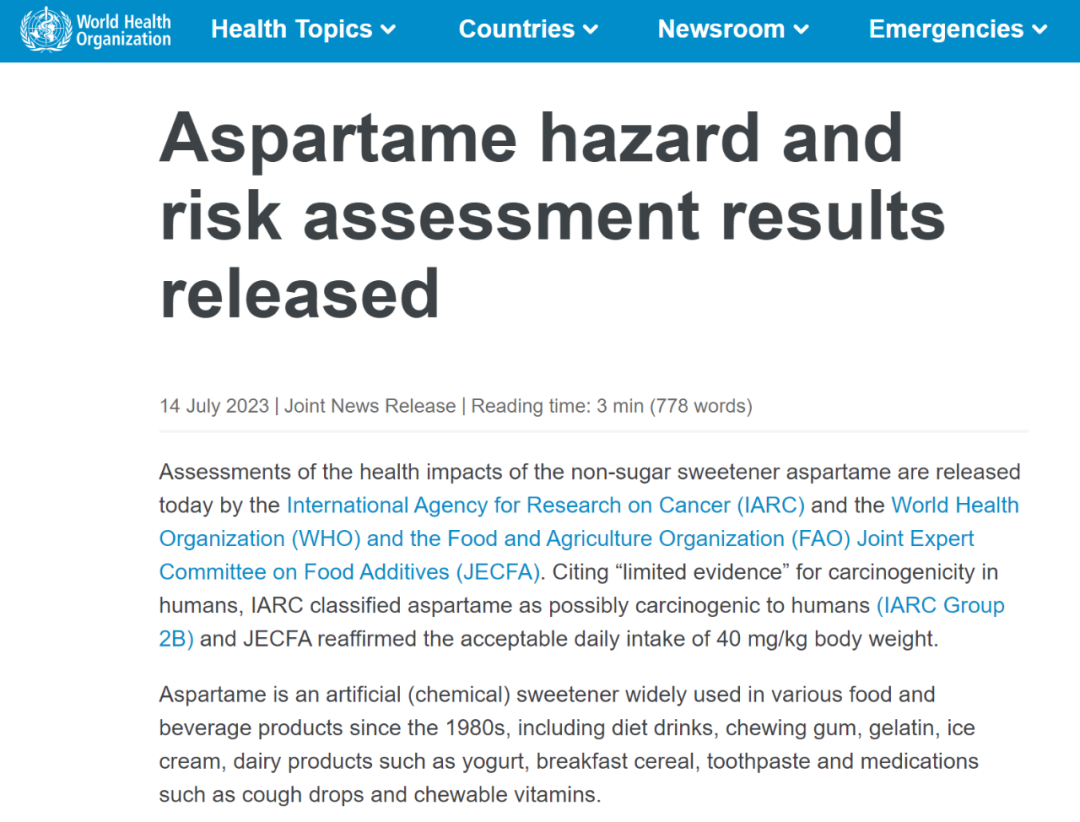NEWS
Time is running out for aspartame.
On July 14, the World Health Organization (WHO) officially announced the news that aspartame may be carcinogenic to humans, and classified aspartame as possibly carcinogenic to humans (Group 2B) substances.
The findings are the result of a joint assessment of the health effects of aspartame by the International Agency for Research on Cancer (IARC), the World Health Organization (WHO) and the Food and Agriculture Organization (FAO) Joint Expert Committee on Food Additives (JECFA).

The World Health Organization has announced on its website that aspartame may cause cancer
Source: WHO official website
How was it assessed?
Can you still eat aspartame?
The Joint Expert Committee on Food Additives (JECFA) has stressed that the acceptable daily intake of aspartame is 40 mg/kg (body weight), and that a person's daily consumption is safe within this limit. Assuming there are no other sources of aspartame intake and drinking aspartame beverages containing 200-300 mg per can, an adult weighing 70 kg would need to consume more than 9-14 cans per day to exceed the acceptable intake.
The evaluation process of the two committees
This assessment of the health effects of aspartame is the first by IARC and the third by JECFA, which has conducted separate and complementary reviews over the past two years to assess aspartame's potential carcinogenic hazards and other health risks.
Among them, IARC's hazard assessment is to understand the carcinogenicity of aspartame from its specific characteristics and the possibility of causing harm, which is the first basic step in its assessment.
JECFA's risk assessment goes a step further, identifying the potential for certain types of harm under certain conditions and exposure levels - in short, the potential for aspartame to cause cancer under certain conditions and exposure levels.
The IARC and JECFA committees' assessment of aspartame's health risks is based on a collection of scientific data, including peer-reviewed papers, government reports and studies for regulatory purposes. To assess aspartame, IARC brought together 25 cancer experts from 12 countries in Lyon, France, to review existing research. These studies have been reviewed by independent experts, and both committees have taken steps to ensure the independence and reliability of their assessments.
There is insufficient evidence for carcinogenesis in humans, but convincing evidence for carcinogenesis in animals
After considering all types of exposure (e.g., diet, occupation), IARC finally classified aspartame into Group 2B, which may be carcinogenic to humans, along with pickles, other pickled vegetables, etc. There are four levels of evidence strength in Group 2B, with aspartame being the third highest level, specifically for insufficient data on causing cancer in humans. But the evidence for cancer in animals is compelling.
Therefore, while announcing probable carcinogenesis, Dr Moez Sanaa, Head of Standards and scientific Advice at WHO, also mentioned that the JECFA Committee, taking into account the evidence of cancer risk in animal and human studies, the evidence of an association between aspartame consumption and human cancer is not yet completely convincing. Longer follow-up and repeated dietary questionnaires, as well as randomised controlled trials, are also needed.
According to relevant media reports, as the United States FDA, which approved aspartame decades ago, criticized the results announced by the WHO in the United States on July 13, saying that the sweetener is safe, and that the WHO classified aspartame as possibly carcinogenic to humans does not mean that aspartame is actually related to cancer.
Synthetic sweeteners meet natural sweeteners
As a synthetic sweetener, aspartame has been used since the early 1980s in a variety of foods and beverages, including diet drinks, chewing gum, ice cream, yogurt and other dairy products, as well as breakfast cereals, toothpaste, cough drops and vitamins.
It is widely used in beverages, such as Coca-Cola (Zero sugar Cola), Pepsi Zero Sugar and other diet soda products. According to The Lancet Oncology, the largest source of aspartame exposure is artificially sweetened beverages.
The use of artificial sweeteners began to decline
In fact, not only aspartame, acesulfamil, sucralose and other artificial sweeteners, in addition to the internal concerns of safety risks, but also face the "external" of natural sweeteners. In recent years, with the rapid development of natural sweeteners, the market for artificial sweeteners has shown a downward trend.
According to Mintel database data, in the decade from 2010 to 2020, the proportion of natural sweeteners increased year by year, from 8.16% in 2010 to 29.41% in 2020. The proportion of artificial sweeteners used has decreased year by year, mainly because natural sweeteners are more in line with new needs such as health, safety, natural and sugar control.
Tianfeng Securities research report shows that as of 2022, in China's sweetener market, synthetic sweeteners accounted for 52%, natural sweeteners accounted for 29%, and sugar alcohol sweeteners accounted for 18.2%. At present, synthetic sweeteners still occupy the mainstream of the entire sweetener market, but the growth rate has been unable to compare with natural sweeteners.
